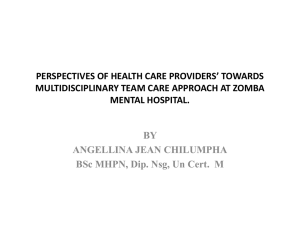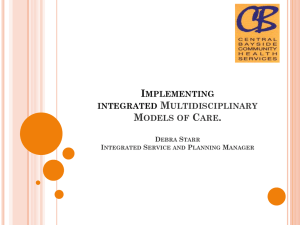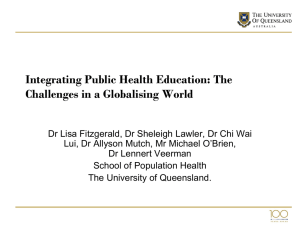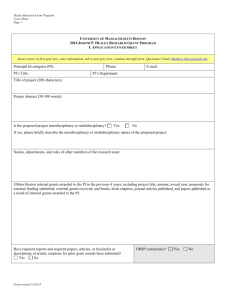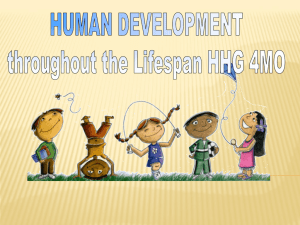Multidisciplinary Collaboration Anette Tronvik, Greta Strikulyte, Lúcia
advertisement
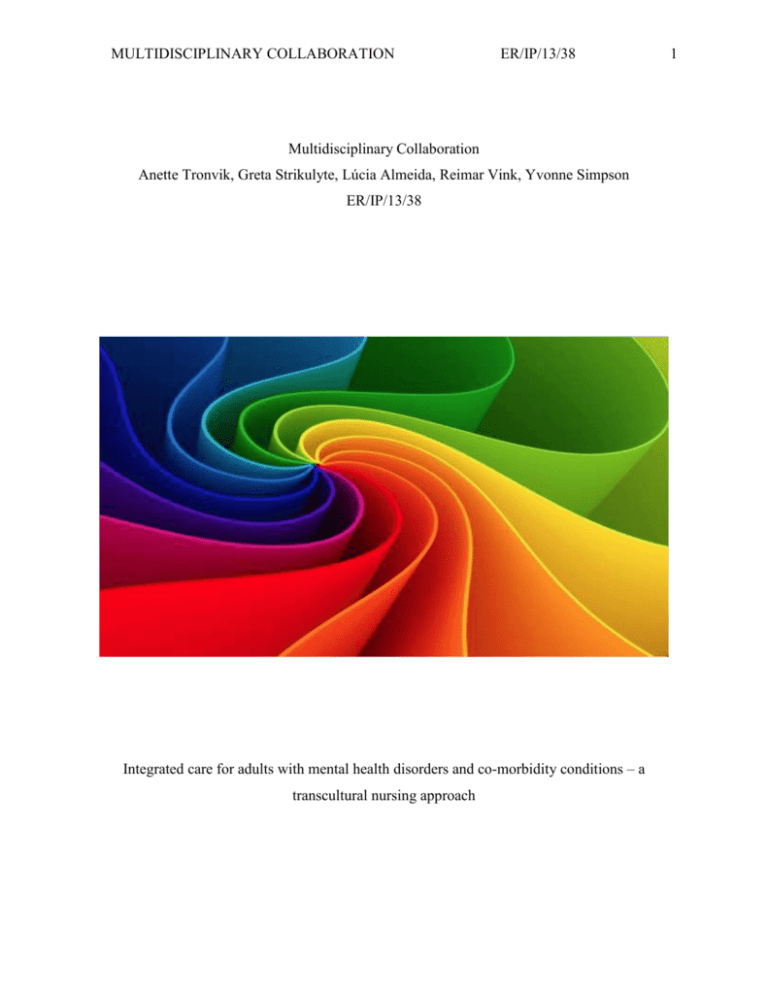
MULTIDISCIPLINARY COLLABORATION ER/IP/13/38 Multidisciplinary Collaboration Anette Tronvik, Greta Strikulyte, Lúcia Almeida, Reimar Vink, Yvonne Simpson ER/IP/13/38 Integrated care for adults with mental health disorders and co-morbidity conditions – a transcultural nursing approach 1 MULTIDISCIPLINARY COLLABORATION ER/IP/13/38 2 INDEX 1. INTRODUCTION ................................................................................................................. 3 2. BACKGROUND .................................................................................................................... 3 2.1. Definitions: ....................................................................................................................... 3 2.2. Research articles ............................................................................................................... 4 2.2.1. “Multidisciplinarity, interdisciplinarity and transdisciplinarity in health research, services, education and policy”................................................................................................... 4 2.2.1.1. Part 1: “Definitions, objectives, and evidence of effectiveness” .............................. 4 2.2.1.2. Part 2: “Promotors, barriers, and strategies of enhancement .................................... 5 2.2.2. 2.3. 3. “Studying Multidisciplinary Teams in the Irish Republic: The Conceptual Wrangle” 5 Participating countries perspectives ................................................................................. 6 DISCUSSION OF DIFFERENT PERSPECTIVES ON MULTIDISCIPLINARY COLLABORATION..................................................................................................................... 8 3.1. Law and guidelines........................................................................................................... 8 3.2. The application of multidisciplinary collaboration .......................................................... 9 4. CONCLUSION .................................................................................................................... 10 5. REFERENCES .................................................................................................................... 11 6. APPENDIX........................................................................................................................... 15 6.1. Appendix 1 ..................................................................................................................... 15 MULTIDISCIPLINARY COLLABORATION ER/IP/13/38 3 1. INTRODUCTION “Multidisciplinary collaboration - a transcultural nursing approach” is the theme that we will explore in our paper. As this is such a wide topic to explore, following a group discussion, we decided to ask the question ‘what are the benefits of multidisciplinary collaboration in mental health’? Deady (2011), highlights that the term multidisciplinary collaboration appears vague and ambiguous. Therefore, we have chosen to use the terms multidisciplinary and interdisciplinary, interchangeably, throughout our paper for this exact reasons. Through the process of self-directed group work, supported by our group tutor, we will use research articles to discuss the theme of our paper. The paper will focus on the multidisciplinary collaboration aspect of the team, focusing less on the patient, due to limited time. To conclude, we will identify key issues related to the provision of mental health nursing in Europe. Additionally, from our group perspectives, we will contribute towards creating a visionary “Golden Standard” of nursing care for multidisciplinary collaboration. Following our literature research on the term multidisciplinary (Appendix 1) we have chosen to use the term interdisciplinary, interchangeably with multidisciplinary throughout our paper. Choi and Pak (2006) highlight that to varying degrees, multidisciplinary and interdisciplinary, involves multiple disciplines working along the same continuum. We used search terms specific to this subject using a PICO. PICO is a method of putting together a search strategy. We used the databases Pubmed, Cinahl and Psychinfo to find the suited articles (Appendix 1). 2. BACKGROUND 2.1. Definitions: Mental health: MULTIDISCIPLINARY COLLABORATION ER/IP/13/38 4 Mental health or psychological well-being is an integral part of an individual’s capacity to lead a fulfilling life (World Health Organization [WHO], 2013). Multidisciplinary: Multidisciplinary means working with several disciplines but with individual goals and where the different disciplines work independently. It doesn’t challenge disciplinary boundaries and the participants learn about each other (Choi & Pak, 2006). Interdisciplinary: Interdisciplinary occurs when others' boundaries are being blurred and the participants learn about and from each other (Choi & Pak, 2006). 2.2. Research articles 2.2.1. “Multidisciplinarity, interdisciplinarity and transdisciplinarity in health research, services, education and policy” 2.2.1.1. Part 1: “Definitions, objectives, and evidence of effectiveness” The article "Multidisciplinarity, interdisciplinarity and transdisciplinarity in health research, services, education and policy, part 1 was published in Clinical and Investigative Medicine. It discusses the definitions of the terms "multidisciplinary", "interdisciplinary" and "transdisciplinary", objectives and the evidence of effectiveness of teamwork. The article highlights that there is an increasing emphasis on multidisciplinary approach in health care and that teamwork is valuable and beneficial towards a more holistic package of care. Teamwork for collaborative care consists of people who share a common purpose and goal, with complementary and overlapping skills. This common approach to work practice, has shown to improve patient outcomes. The article emphasis the reasons for multiple disciplinarity is to resolve problems, provide different perspectives on a problem and provide comprehensive services, such as health care and health education. The benefits of teamwork are increased learning, better utilization of resources and planning, minimization of unnecessary costs and improving job performance and work quality. Other benefits are also discussions between MULTIDISCIPLINARY COLLABORATION ER/IP/13/38 5 professionals, networking, gaining new insights and skills. However, it also states that multiple disciplinarity teams do not always work, that there is little documented evidence in literature about the effectiveness (Choi & Pak, 2006). 2.2.1.2. Part 2: “Promotors, barriers, and strategies of enhancement The second part (of the above paper) examines the promoters and barriers for successful multiple disciplinary teamwork. Teamwork success is based on a good selection of team members, good team leaders, maturity, flexibility of team members and a personal commitment. Additionally, a common goal, and shared vision, clarity, rotation of roles and good communication are essential. Barriers to successful teamwork include, the poor selection of disciplines and team members, poor process of the team functioning and a lack of proper measures to evaluate success of interdisciplinary work. Additionally, the lack of guidelines for multiple authorship in research publications, language problems, insufficient time for the project, institutional constraints, discipline conflicts, team conflicts, lack of communication between disciplines and unequal power among disciplines. The paper highlights eight strategies to enhance multiple disciplinary teamwork, which can be summarized in the acronym TEAMWORK - Team, Enthusiasm, Accessibility, Motivation, Workplace, Objectives, Role and Kinship. However, Choi and Pak emphasise that not every health project needs to involve multiple disciplines. Therefore, the pursue of a multiple disciplinary approach has to be questioned (Choi & Pak, 2007). 2.2.2. “Studying Multidisciplinary Teams in the Irish Republic: The Conceptual Wrangle” The article “Studying Multidisciplinary Teams in the Irish Republic: The Conceptual Wrangle” is a literature review paper written in 2011 and was published in Perspectives in Psychiatric Care. It states that good teams are engaging in dialogue, which they do in an open and proactive manner, whilst poor teams avoid dialogue that had potential for conflict. The article also argues that interdisciplinary work directed towards improving patient outcomes, might not always improve teamwork. It states that the common purpose, professional contribution, skills, communication, coordination and joint thinking, appear to be key features in good teamwork. When these common goals are not met, the likelihood for conflict and disagreement are more MULTIDISCIPLINARY COLLABORATION ER/IP/13/38 6 probable. The team leaders have to be cognizant of assuming that their own perception of team membership are shared by the other members. The perspective of some of these members of the multidisciplinary team may extend beyond the group, and be more inclusive or exclusive. (Deady, 2012) The above articles are complimentary to each other on many points, such as, professionality, the use of effective communication and patient outcomes. The articles highlight the benefits of good teamwork, but also emphasise that sometimes, to strive for good patient care, does not always mean good teamwork. They also emphasise that poor teamwork, can at times cause arguments, which the members of the team will avoid by not engaging in dialogue, as much as they are supposed to. This can result in poor communication which you do not want, because the communication is a key component of good teamwork. 2.3. Participating countries perspectives Lithuania: According to the Lithuanian Mental Health Care Act 1995, professionals who work in the field of mental health, must work in collaboration. The Act emphasises that interdisciplinary teamwork in essential within the various branches of science. All branches of science relating to the care or treatment are parts of the team and contribute to the development of treatment, evaluation and coordination (LR psichikos sveikatos priežiūros įstatymas 1995 m.). The mental health sphere is a multidimensional phenomenon. Therefore, professionals who work in the area of psychiatry, always work in interdisciplinary teams. However, the Lithuanian health care system is still dominated by the medical model of working, which hinders all the possibilities of interdisciplinary team (Alseikienė Z., 2005). According to Germanavičius (2004) traditionally teamwork is “only on paper”, but in reality, it turns into “command execution” in hierarchical structure, whilst those on top of the pyramid are “most competent”, i.e. psychiatrists. Norway: The Norwegian Government's focus is the importance of increasing health prevention, health promotion and multidisciplinary collaboration (Helse- og omsorgsdepartementet, 2013-2014). The municipal services are often fragmented, a patient can get new medical staff and new MULTIDISCIPLINARY COLLABORATION ER/IP/13/38 7 therapeutic regimens when he/she goes from out-patient clinics to subacute or to a day ward even within the same hospital. A major challenge is the trust between services and professions. Conflicts arise about knowledge, treatment and power in the treatment system (Almvik & Borge, 2006). "Lov om helsepersonell", § 4 requires professionals to interact and collaborate with each other (Helsepersonelloven, 1999). The reform "Samhandlingsreformen" states that patients will get the right treatment, at the right time and at the right place, through comprehensive and coordinated health care services (Stortingsmelding 47, (2008-2009), 2009) "Lov om pasient- og brukerrettigheter", § 2-5 gives patients the right to have an Individual Plan (Pasient- og brukerettighetsloven, 1999). The Individual Plan is a tool and a method of cooperation between patients and between the various service providers, to ensure comprehensive, coordinated and individualized services (Helsedirektoratet, 2012). Netherlands: In the Netherlands they incorporate multidisciplinary guidelines to improve collaboration. However, studies show that not all healthcare professionals use these guidelines in mental healthcare (Sinnema, Franx, van't Land, 2010). The consequence is, that the available knowledge in these guidelines about diagnostics, treatment and guidance of patience with anxiety, depression, schizophrenia, eating disorders and many other mental issues, isn't used as much as they should be. In the Netherlands the mental healthcare professionals strive towards more healthcare professionals will use these guidelines, which will result in better knowledge in how to treat a patient across multiple disciplines (Sinnema et. al, 2010). It is also important that they revisit and alter these guidelines. The reason for this is, to implement any changes following research on one of these illnesses which may improve the way the patient is treated, which again results in better and faster recovery. Communication between the disciplines is of utmost importance (Aarts & van Woerkom, 2008). Portugal: The Portuguese "Lei da Saúde Mental" (1999) states that external consultation and intervention in the community, including home support and development programs for health promotion and disease prevention, should be provided in each geo-demographic sector by multidisciplinary teams (Diário da Republica- I Serie - A, 1999). In Portugal the access to mental health care is MULTIDISCIPLINARY COLLABORATION ER/IP/13/38 8 limited by the lack of specialists in public mental health services, presenting a huge barrier to integrated interdisciplinary collaboration. It’s also important to mention the low development in community services, resulting in a high rate of hospitalization and preferential use of the emergency services caused by the difficulties of making appointments with physicians. Additionally, the interval between discharge and subsequent consultation associated with the proportion of re-admissions occurs without any contact with outpatients, suggesting the existence of problems of continuity of care. However, integrated care programs and family health units are being developed and units of psychiatry and mental health in general hospitals is a project in construction (Plano Nacional de Saúde Mental, 2008). Scotland: In Scotland multidisciplinary collaboration means that services providing care, treatment and support for adults with mental health disorders and comorbidity conditions must share common health goals with other health care professionals. The Scottish Government (2011) emphasise that multidisciplinary collaboration in mental health services produces a more effective and person centred service and wants local authorities to ensure that there is equality in the provision of mental and physical health across health, social care and other local services. The implementation of the Mental Health (Care and Treatment) (Scotland) Act 2003 placed the rights and treatment of mental health at the center of mental health services. Whilst the Scottish Government’s mental health strategy 2012-2015, reinforces partnership working as an essential role in supporting people with mental illness (The Scottish Government, 2011). The implementation of such laws, ensures that multidisciplinary collaboration is the practice, throughout the healthcare system in Scotland. 3. DISCUSSION OF DIFFERENT PERSPECTIVES ON MULTIDISCIPLINARY COLLABORATION 3.1. Law and guidelines According to the Lithuanian Mental Health Care Act 1995, professionals who work in the field of mental health, must work in collaboration. The Portuguese Law on Mental Health (1999) also MULTIDISCIPLINARY COLLABORATION ER/IP/13/38 9 emphasises that external consultation and intervention in the community, should be provided in each geo-demographic sector by multidisciplinary teams (Diário da Republica- I Serie - A, 1999). Norway have several laws pertaining to collaboration and coordinated care: "The Healthpersonel Law", § 4 requires professionals to interact and collaborate with each other (The Healthpersonel Law, 2011). Additionally, "The Coordination Reform" states that patients will get the right treatment, at the right time and at the right place, through comprehensive and coordinated health care services (St.Meld. 47, 2008-2009). However, in the Netherlands there are no governmental laws that stipulate multidisciplinary collaboration in mental health services. Multidisciplinary guidelines are incorporated into practice within some services to improve collaboration. However, studies suggest that not all healthcare professionals use these guidelines in mental healthcare (Sinnema, Franx, van't Land, 2010). Scotland appears to have several laws that promote multidisciplinary collaboration in mental health services. Additionally, the Scottish Government’s mental health strategy 2012-2015, reinforces partnership working as an essential role in supporting people with mental illness (The Scottish Government, 2011). 3.2. The application of multidisciplinary collaboration The Lithuanian health care system is required to work collaboratively. However the health care system continues to be dominated by the medical model of working, which hinders all the possibilities of interdisciplinary team (Alseikienė Z., 2005). In contrast, the Norwegian Government's focus is on the importance of increasing health prevention, health promotion and multidisciplinary collaboration (Department of Healthcare, 2013-2014). In Portugal access to mental health care, is limited by the lack of specialists in public mental health services, presenting a huge barrier to integrated interdisciplinary collaboration (Plano Nacional de Saúde Mental, 2008). However in Scotland, multidisciplinary collaboration enables all local authorities to ensure that there is equality in the provision of mental and physical health across health, social care and other local services (Scottish Government, 2011). In the Netherlands, mental healthcare professionals strive towards the promotion of multidisciplinary guidelines (Sinnema et. al, 2010). As the group reflected upon the individual laws, guidelines and application of multidisciplinary collaboration there was much to discuss. It was agreed that having laws and guidelines to outline MULTIDISCIPLINARY COLLABORATION ER/IP/13/38 10 multidisciplinary collaboration in mental health services, benefits both the service and the service user. We identified that the laws pertaining to multidisciplinary collaboration above were noted to be similar. However, not all countries applied these laws to practice. In Lithuania, a hierarchal communication existed which resulted in the lack of collaboration between professionals. Whilst in Portugal a lack of finances, resulted in reduced staff levels which impacts on multidisciplinary collaboration. 4. CONCLUSION Throughout our paper we have explored the benefits of multidisciplinary collaboration from a transcultural nursing perspective. From a group perspective, we believe that there are a great number of benefits for this approach, within mental health servises. Therefore, in our conclusion, we would like to propose our visionary “Golden Standard” of nursing care for multidisciplinary collaboration, in mental health services. Key benefits of a multidisciplinary collaborative approach: -Incorporates team work, allowing for open discussions between professionals and a sharing/ overlapping of skills (Choi & Pak, 2007). -It envelops a holistic package of care (Choi & Pak, 2006). -Improves patient outcomes (Deady, 2012). Videbeck (2013) highlights that the nurse’s role in mental health is to provide a person centred, holistic package of care and treatment. Therefore, as a group we believe that the above three key benefits, would work towards creating a ‘Golden Standard’. It would also ensure that individuals with a dual diagnosis and/ or comorbidity conditions recieved a package of care, inclusive of the professional input from a multidisciplinary team. To implement this we believe that there must be less ambiguity on the terms used for collaborative care in mental health and agree that the term interdisciplinary, should be the generic term used in Europe. To give a visual idea of what the difference is between multidisciplinary and interdisciplinary, imagine two or more circles. Every circle represents a MULTIDISCIPLINARY COLLABORATION ER/IP/13/38 11 discipline. Multidisciplinary is represented by the circles seperated from each other whilst, in interdisciplinary, the circles are partially overlapping. (Choi & Pak, 2006). We also believe that by utilising the acronym TEAMWORK - Team, Enthusiasm, Accessibility, Motivation, Workplace, Objectives, Role and Kinship (Choi & Pak, 2007), collaborative work in interdiscipinary care would be enhanced. Teamwork and interdisciplinary collaboration have been shown to shorten the patients hospital stay. Care models which include the patients education, psychiatric and primary care co-management, improves the patients outcomes. For example the patients that suffer from depression and panic disorders are more adherent to medication, have decreased depression scores and have fewer symptomatic days. All this through interdisciplinary collaboration (Choi & Pak, 2006). As a group, we found that one of the most important parts of interdisciplinary collaboration is good communication. Without communication no one within the interdisciplinary team will know what the other one does. Deady (2012) emphasises that effective teams engage in dialogue. Nurses are the eyes and ears for the rest of the team. If they do not communicate about what they see and hear, how will the psychiatrist know if the medication is working? This also applies to the rest of the team. They all have to work in an interdisciplinary way and not in a multidisciplinary way. The ‘Golden Standard’ should therefore be inclusive of; the acronym TEAMWORK - Team, Enthusiasm, Accessibility, Motivation, Workplace, Objectives, Role and Kinship, incorporate effective interdisciplinary teams, with good communications and work collaboratively, for the good of the patient. 5. REFERENCES Aarts, N. & Woerkom, van, C, (2008). Strategische communicatie (2nd ed.). Assen: Gorcum B.V. Almvik, A. & Borge, L. (Red.). (2006). Psykisk helsearbeid i nye sko. Bergen: Fagbokforlaget. MULTIDISCIPLINARY COLLABORATION ER/IP/13/38 12 Alseikienė, Z. (2005) Komandos vaidmuo medicinoje. Gydymo menas. 2005, p. 35-36. Choi, B. C. K. & Pak, A.W. P. (2006). Multidisciplinarity, interdisciplinarity and transdisciplinarity in health research, services, education and policy: 1. Definitions, objectives, and evidence of effectiveness. Clinical and Investigative Medicine, 29(6), 351364. Choi, B. C. K. & Pak, A. W. P. (2007). Multidisciplinarity, interdisciplinarity, and transdisciplinarity in health research, services, education and policy: 2. Promotors, barriers, and strategies of enhancement. Clinical and Investigative Medicine, 30(6), 224-232. Deady, R. (2012). Studying Multidisciplinary Teams in the Irish Republic: The Conceptual Wrangle. Perspectives in Psychiatric Care, 48, 176-182. doi: 10.1111/j.17446163.2011.00326.x Germanavičius, A. (2004) Komandinis darbas medicinoje ir psichiatrijoje. Slauga. Mokslas ir praktika. Retrieved from: http://www.elibrary.lt/resursai/Ziniasklaida/Slauga/MP/2004/slauga_2004_12.pdf Helse- og omsorgsdepartementet (2013-2014). [Ministry of Healthcare] Kap. 764 Psykisk helse. Retrieved from: http://www.regjeringen.no/nb/dep/hod/dok/regpubl/prop/2013-2014/prop-1-s20132014/4/6/4.html?id=739866 Helsepersonelloven. (1999). Lov om helsepersonell (helsepersonelloven).[The Healthpersonel Law]. Retrieved from: http://www.lovdata.no/all/tl- 19990702-063-002.html Helsedirektoratet (2012). Individuell plan og koordinator [Individual Plan]. Retrieved from: http://helsedirektoratet.no/helse-og-omsorgstjenester/habilitering-rehabilitering/individuellplan/Sider/default.aspx MULTIDISCIPLINARY COLLABORATION ER/IP/13/38 13 Lietuvos respublikos psichikos sveikatos priežiūros įstatymas (1995) Nr. I-924[Lithuanian Mental Health Care Act], p. 4-5. Mental Health (Care and Treatment) (Scotland) Act 2003. asp 13. Retrieved from: http://www.legislation.gov.uk/asp/2003/13/contents. Ministério da Saúde (1999). Diário da República, Lei nº 35. Ministério da Saúde, Alto Comissariado da Saúde (2008). Plano Nacional de Saúde Mental: 2007-2016. Pasient- og brukerrettighetsloven. (1999). Lov om pasient- og brukerrettigheter (pasient- og brukerettightesloven. [Patient and User Rights Act]. Retrieved from: http://www.lovdata.no/all/tl- 19990702-063-002.html Sinnema, H., Franx, G., & Van't Land, H. (2010). Multidisciplinaire richtlijnen in de ggz . Utrecht: Trimbos-instituut. St.meld. nr. 47 (2008-2009). (2009) [White Paper, no. 47] Samhandlingsreformen-rett behandling-på rett sted-til rett tid. Retrieved from: http://www.regjeringen.no/nb/dep/hod/dok/regpubl/stmeld/2008-2009/stmeld-nr-47-20082009-.html?id=567201 The Scottish Government (2011). The Scottish Government’s mental health strategy 2012- 2015. Retrieved from: http://www.scotland.gov.uk/Publications/2012/08/9714/0. Videbeck, S. (2013) Psychiatric-mental Health Nursing. (6th ed.). Philadelphia: Lippincott Williams & Wilkins. MULTIDISCIPLINARY COLLABORATION ER/IP/13/38 World Health Organization. (2013). Risks in mental health: an overview of vulnerabilities and risk factors. 14 MULTIDISCIPLINARY COLLABORATION ER/IP/13/38 15 6. APPENDIX 6.1. Appendix 1 Date Database Search words Limits Hits and selection 04-03- Cinahl with (MH "Collaboration") AND (MH "Mental Full 28 hits 2014 fulltext via Health") OR (MH "Research, Mental Health") text 1 chosen EBSCO OR (MH "Mental Health Personnel") (MH "Research, Interdisciplinary") OR (MH "Multidisciplinary Care Team+") 04-03- Pubmed via "Multidisciplinarity" AND "Interdisciplinarity" Full 4 hits 2014 AND "Transdisciplinarity" text 2 chosen bib.hva.nl


